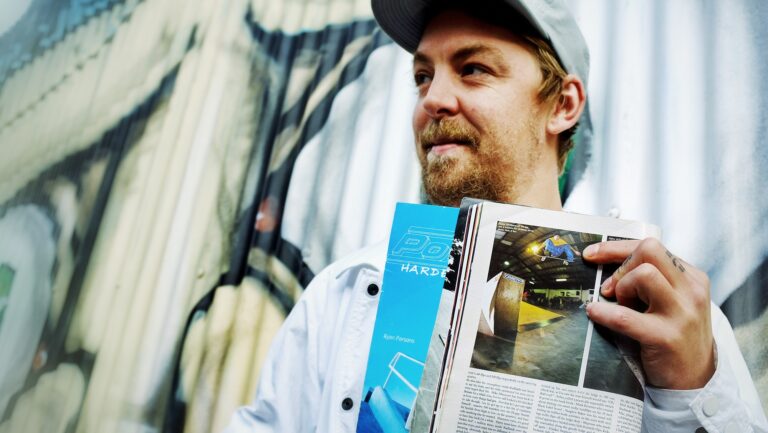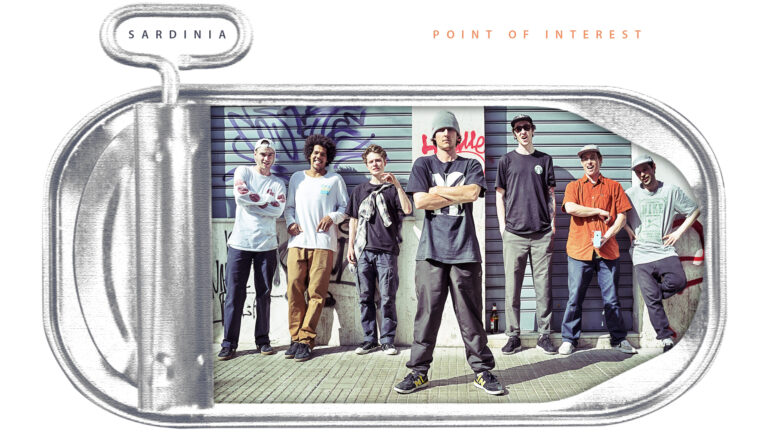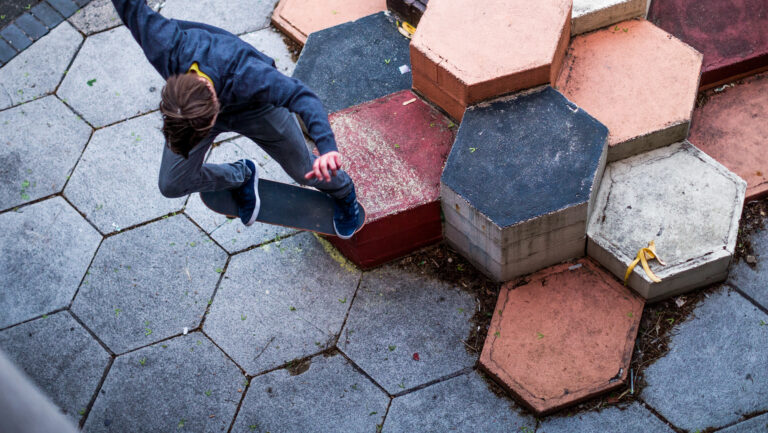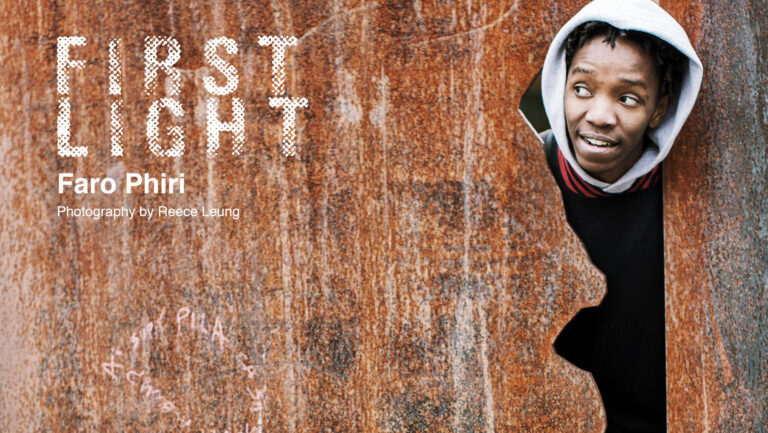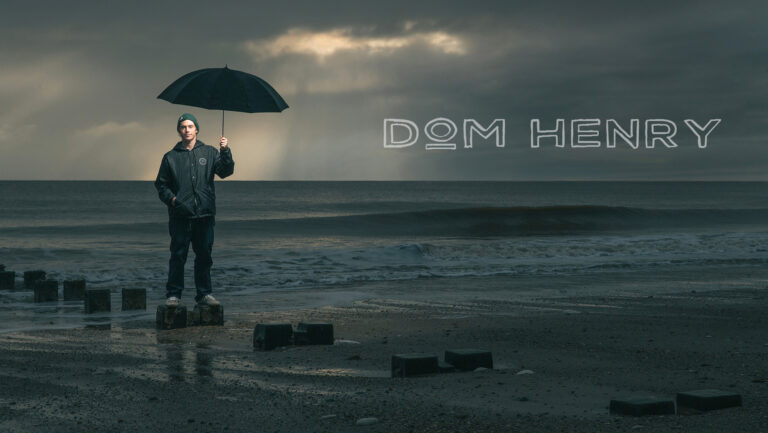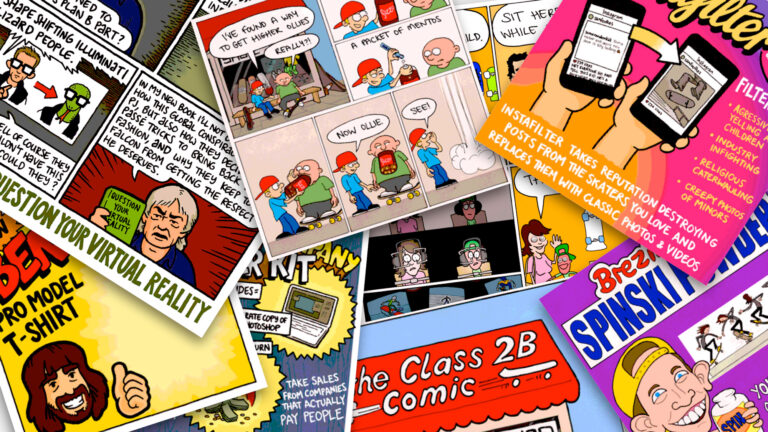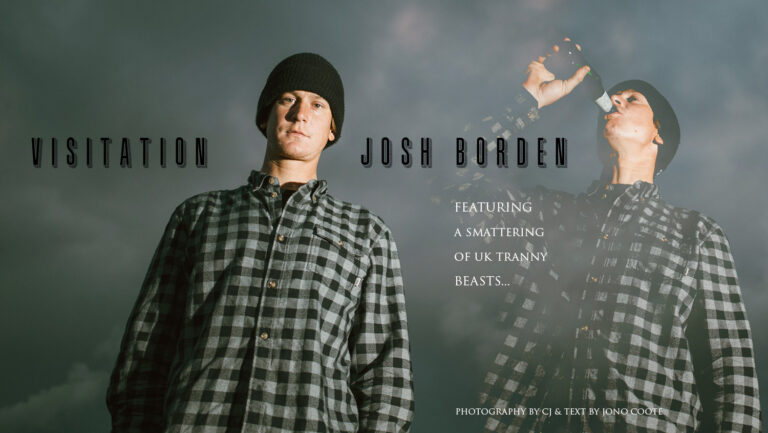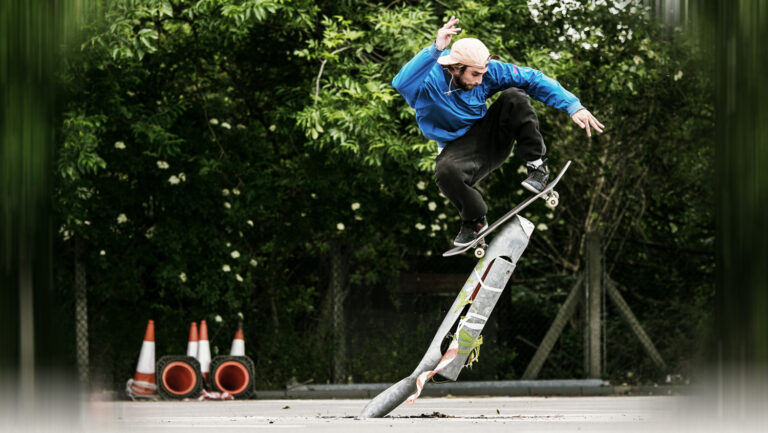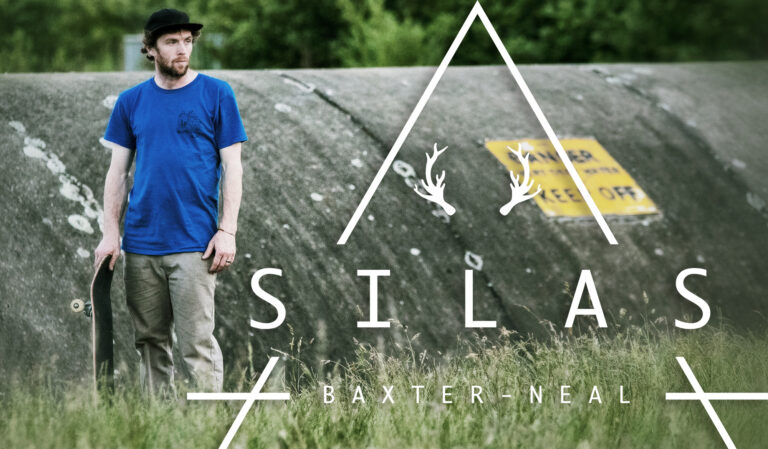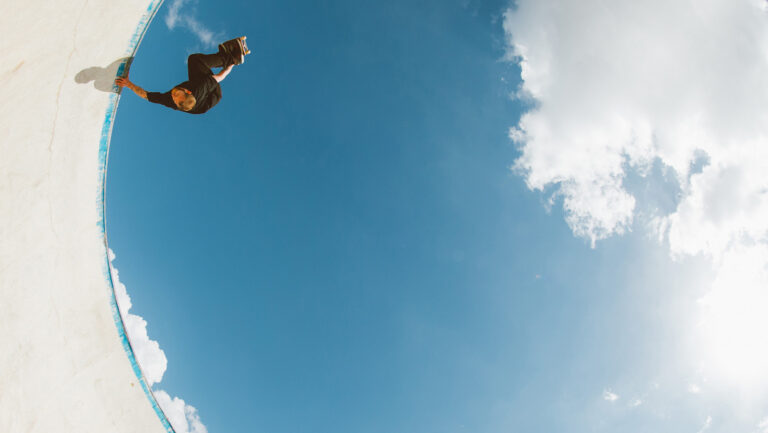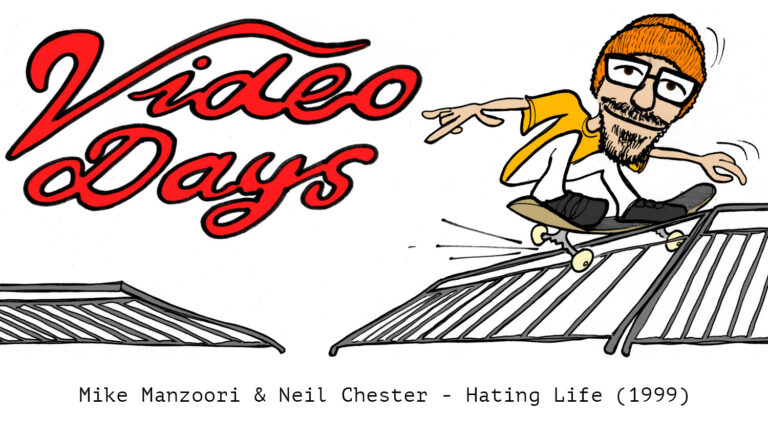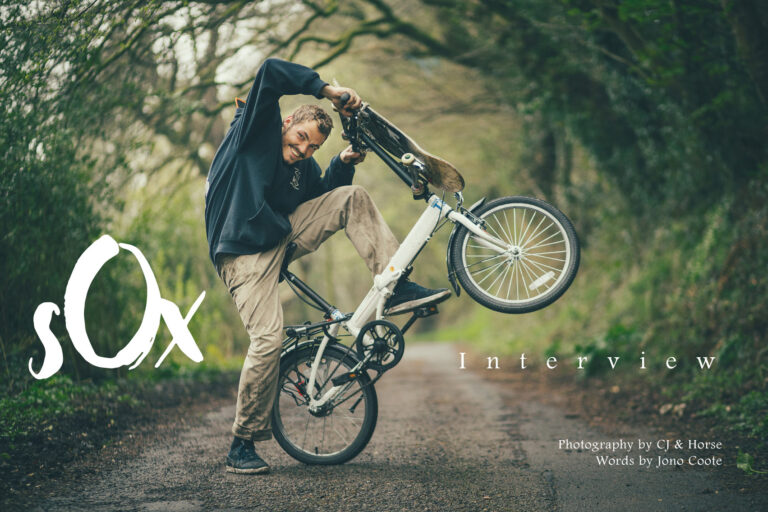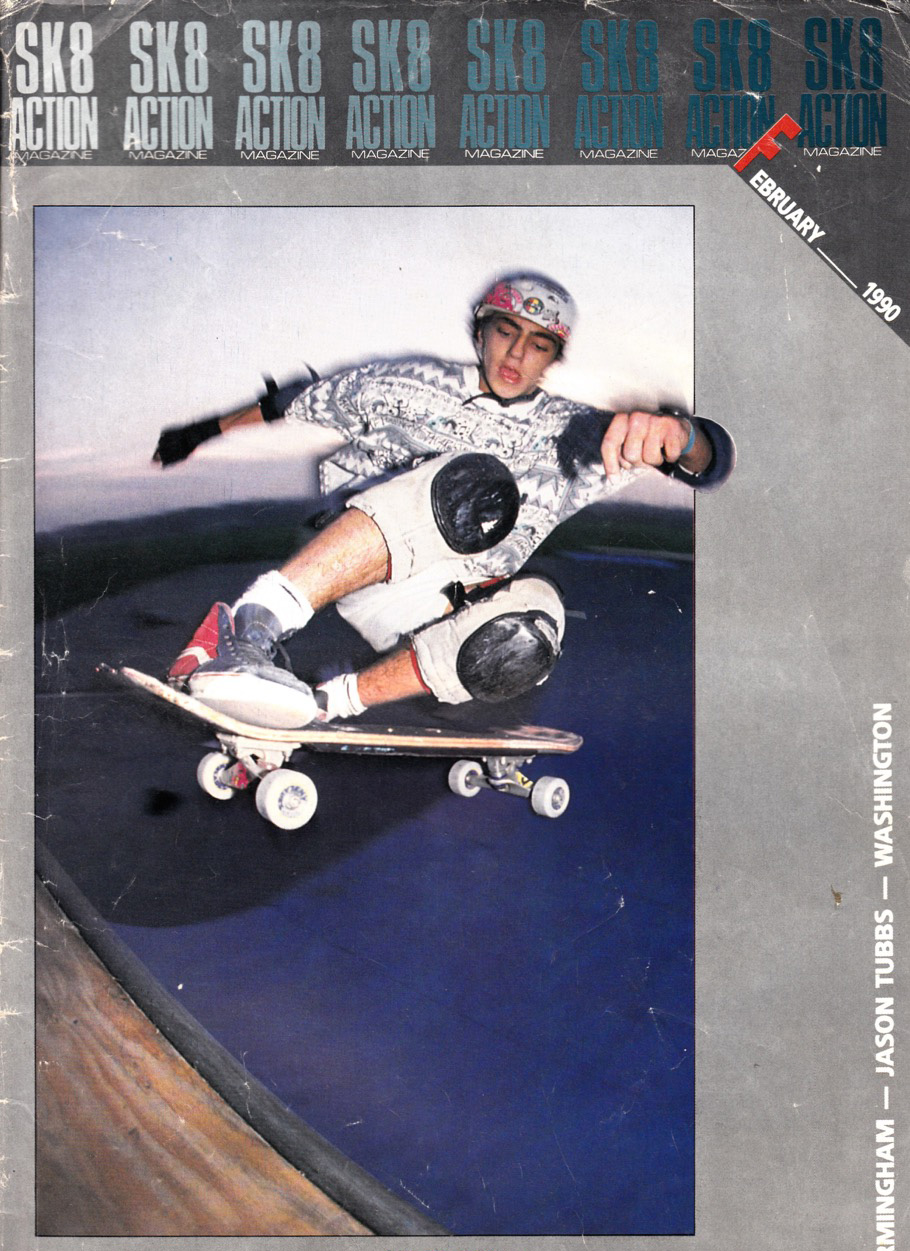
UK ATV legend Mike Manzoori has always been a lot more interested in the act of skateboarding than in talking about skateboarding: especially so when it comes to talking about his own skateboarding. Despite the massive amount of coverage that Mike’s had throughout the years, (his first cover was at the age of 15, and for a couple of decades it was rare to pick up a magazine without a photograph or a mention of him), video parts and interviews are relatively rare. His time spent skating for Powell, Santa Cruz, ATM Click, Adrenalin, Etnies, Sheep and Pig over the last three decades has generated a moderate amount of footage, but it’s Neil Chester’s 1999 masterpiece, ‘Hating Life’, that best illustrates Mike’s skating as it really is. Charging through the streets of London, making spots out of non-spots and tearing apart the crusty Harrow halfpipe: it wasn’t a surprise to learn that Neil –literally– had trouble keeping up with Mike’s trail of four-wheeled trail of destruction during the filming of this UK VHS classic.
From Caramacs and Cantelowes to cameras and California, it’s pretty rad that the guy who was once reluctant to set foot beyond the M25 is now working as filmer/editor in LA for the very Sole Tech empire that commissioned and funded Hating Life as discussed here. It’s even better that Neil and Mike gave up their time to talk about that section. If you’re a fan of Mike and Neil and their collaboration on Hating Life already, then prepare to dive into the minutiae. If you’re not already aware of this section, or the two guys involved in creating it, get ready for a treat.
Text: Neil Macdonald
How did ‘Hating Life’ come about? Did A4 or Sole Tech approach you, or did you suggest it to them? Was there a budget?
Neil Chester: I’m not sure who introduced me to the A4 guys initially, but they wanted to make a video to showcase their team across the three brands they distributed: Etnies, Emerica and éS. They had quite a big team in total and some rad guys, so it was on from my end, and yeah, they paid me a monthly rate just to go out and make it! I literally drove solo all around the country filming all the guys until it was done.
What had you worked on previously, apart from, obviously, ‘Through the Eyes of Ruby’?
N: Yeah, that was the only thing really, and I filmed a bunch for early Blueprint and Panic videos too, as I was friendly with some of the riders.
Was everything on the Hating Life filmed specifically for it, or did you have footage you could use before you started filming?
N: No, the A4 video was 100% me. I think maybe one or two of the riders had a few tricks, but I’m not sure if any got used; maybe one or two did. I guess I was heavy on the filming quality!
Did you already know everybody involved? Had you filmed any of those guys before? Were they hanging out much during filming?
N: A few I knew from seeing them here and there at contests, events etc. But most I got to know through filming with them. It was great to meet and stay with all the guys; I’d literally just go and stay with them for a week or so and go on missions. Scott Palmer came on board right at the end of filming and he was a friend so we quickly got some footage of him filmed.
Mike Manzoori: I knew most of the other skaters in the video, or at least knew of them, but we didn’t skate together much for this project as we all lived in different parts of the UK. I think Neil just did the rounds and visited us. Also I had just returned home from a few years in California so I was pretty out of the loop.
Was Andy Scott’s section really filmed in one day? I remember seeing him skate that Bolton park, and it was like watching Ben Leyden or Div skate Livi – he can do every trick on every inch of the place, every time.
N: Yeah, I think it was: just one night at Bones skatepark in Bolton. He can knock that stuff out. It would be crazy if you actually had to film him and he was 100% into it. But Andy ‘just does it’ whenever he wants, and not so much just because you have to film a video and force it.
How long did Mike’s part take?
N: Mike’s part was crazy, since he wasn’t on the UK team so to speak; he was just in London at the time because he was waiting on a USA visa. He’s a super active guy and he was very motivated. We both just stayed in London and went out every day for about three weeks. Then I’d go film someone else, then come back to London for another week or so.
M: I honestly don’t really remember. I want to say we did it within a couple of months. I think I was a bit of an afterthought for that video ’cause the project was already well under way with the UK team, and I happened to be back in the UK at the time, so I got involved more towards the end but Neil would know better. I have trouble remembering yesterday! (Laughs).
How often were you filming? Was it lots at once, or lots of bits over a longer time?
M: I want to say it was a fairly condensed period but again Neil would probably answer that more accurately. I do remember trying to stack as many clips as possible on any day out filming for two reasons: the first reason is that Neil would drive a long way to film so I wanted to ensure his time was spent well, and the second reason was that I loved how in old videos, like Blind’s Video Days, you could almost dissect it down to a handful of sessions ’cause of the clothes they had on, and the locations. You could tell that they were skating together a lot and that a lot of tricks went down in the same day. So I do remember being pleased with my ratio of tricks to outfits, (laughing). It’s a very different approach to a current video part. These days, people are killing themselves over every trick to achieve their most pinnacle performance, which is fantastic in its way, but I had neither the skills nor the endurance so I kinda opted for the ‘this is just how I skate’ approach. Hats off to Neil for going the distance every day we filmed together ’cause we would cover a lot of ground in a day.
N: Yeah, it was filmed only over a month or two and when Mike was in town. I’d come to London for a week or so and just go out every day and film literally all day, back in the video-light days. We’d be out from 11am until 11pm. Also, we did a trip to Peterborough as Mike’s mum was living up that way and we hit some spots there. It was a very real way to film skateboarding; Mike was a machine and knew London so well.
How many Kind hats do you think your mum made Mike? Did she end up needing help to meet demand, or did the operation just wind down? I had two and I’ve still got one, and it’s the best hat I’ve ever owned.
M: Glad you like it. My mum made them all by hand. She loves knitting and always has. At the time we had just lost my stepdad to cancer so she was going through a lot of very heavy stuff. So I came up with Kind as a little project to help her shift focus. The response was great and I hear a few people saying they still have their beanies, which means a lot to me. That was when I was getting my visa for America and moving away, so I think it just wound down ’cause she was more into knitting than she was calling shops for re-orders. Huge thanks to the skate shops and skaters that supported Kind, it really meant a lot.
What’s Mike like to film with Neil?
N: Well at the time, it was like he was taking me out filming, we would just push all over the city. And he pushed full pelt all around, all day. I was properly tired by the end of the day, quite literally a full day filming and hitting about seven or eight spots as opposed to today where you probably go to two spots all day! I just remember the speed; it was a serious job just to keep up with him around London, which he knew so well. Every street.
It always appeared that you probably did a lot of travelling around making Hating Life. Did you just jump on tours, or were these specific filming missions?
N: All separate filming missions to the various cities where the guys lived, we did one trip to Marseille, via Nantes, for a contest. That was great, drove the whole way stopping at random places, we picked up some footage there. But it was mainly me going to them; like filming Rodney actually in St. Albans and around that area.
Whose choice was Mike’s song? Which came first, the song, or the drop-in-melon-grab on the vocal?
N: It was my choice, just a song I liked from The Big Lebowski soundtrack. I’d always listen to music back then pretty much with the sole intention of figuring out if it would work in a skate video or not! And it was obvious we should edit that trick to that lyric once the footage was sitting on the timeline.
M: I don’t remember getting a say in the music or anything. I saw the part once it was all done. Neil picked the music, which was a good choice. I liked the track but I think he assumed I knew of the movie The Big Lebowski and he was pretty hyped on the choice because of that. I hadn’t seen the movie – I’m usually way late on popular culture – so I don’t think I reacted with the amount of hype he was expecting. It made me watch the movie though, which I now love.
Is there anything you’d like to have re-shot in your part Mike?
M: There’s a line in Birmingham where I front board up the top of a rail and then ollie over the other rail… I wanted to grind the second rail but I’m awful at grinding rails, so I settled for the weakness. I think Neil used everything we shot ’cause there were a few tricks that just happened along the way that could have definitely been cut. I remember thinking the part felt like watching two minutes of filler tricks; so to have fillers between more fillers brings the yawn for kids watching…(laughs). I should have watched the video again before answering this ’cause I don’t remember too much of it, and I’m driving through Texas right now.
What about from the filmer’s perspective Neil?
N: Not from what I remember, it was a haze… Some of the spots were just found by the road, like the smith up the metal fence by Waterloo that just happened to be knocked over. For the ‘Just dropped in’ trick, we were just passing by Baker Street and he just did it, camera out and back in bag inside ten minutes. It was all very spontaneous; I’d never really experienced filming anyone else like this before working with Mike.
Were many of Mike’s tricks planned?
N: Not really. Or we’d head out to a certain area of London to skate something specific but we’d push to and from there unless it was really far, then we’d get the tube. But we’d push most places and that gave a unique look to the part that I’m glad people can see: pure spontaneity and raw street skating. I doubt you could get away with filming a part like this now, with ABDs etc, and the general level is so high these days that it kind of prevents this raw approach, but you do see it today in some ways. I guess the whole new wave of hardware brands preach this, whether Palace’s lo-fi style or Polar’s feeling that they bring. It’s ripe for change now!
M: I was back living in London at the time and always had an ongoing mental list of spots and tricks, so I’d drag Neil through the streets, from spot to spot. We would often hit things on the way that weren’t planned, which is always a nice bonus. I had just spent a summer in Philly skating with Ricky, Sergei, and the Sub Zero crew, and was stoked they shared my philosophy of skating from spot to spot and making the most of everything in between. Not everyone shared my enthusiasm for pushing around so I guess if there was anything I wanted to achieve, it was to show that side of skating more
Is there anything we can’t see, like a big hole in the run up or anything like that?
M: It’s all filmed in the UK so there are probably all kinds of cracks or rough surfaces that made every spot a little harder, (laughs). If you’ve never skated in the UK you just don’t appreciate how challenging the terrain is. My right foot had two dislocated toes that were left untreated for years ’cause I didn’t have medical insurance while in America. The smallest toe and the one next to it had been out for so long that they moved up my foot over the long bone that they should have been joined to. So I would run two thick insoles in that shoe, with holes cut out to accommodate the tips of the long bones below. Needless to say bailing hurt a lot and I’d favour my other foot even when it made no sense, which is how I developed back problems. Note to the youths: if you get hurt, I know you want to shred again ASAP but don’t be too hasty, let things heal right and you can enjoy skating for years to come…
Did the video have a deadline?
N: Yeah it was about 10 months, then Scott palmer got on éS and we extended it for a month or two to include him.
You didn’t get a camera jacked at any point, did you?
N: No, I’ve never had a camera robbed or had any knife pulled on me. Surprising for filming in London for so long!
Mike, have you had any cameras jacked since that 411/ATM one?
M: For how many sketchy situations we film in thankfully not too many incidents like that over the years. There was that time in Peru when I got a gun in my face for my camera but that could happen anywhere.
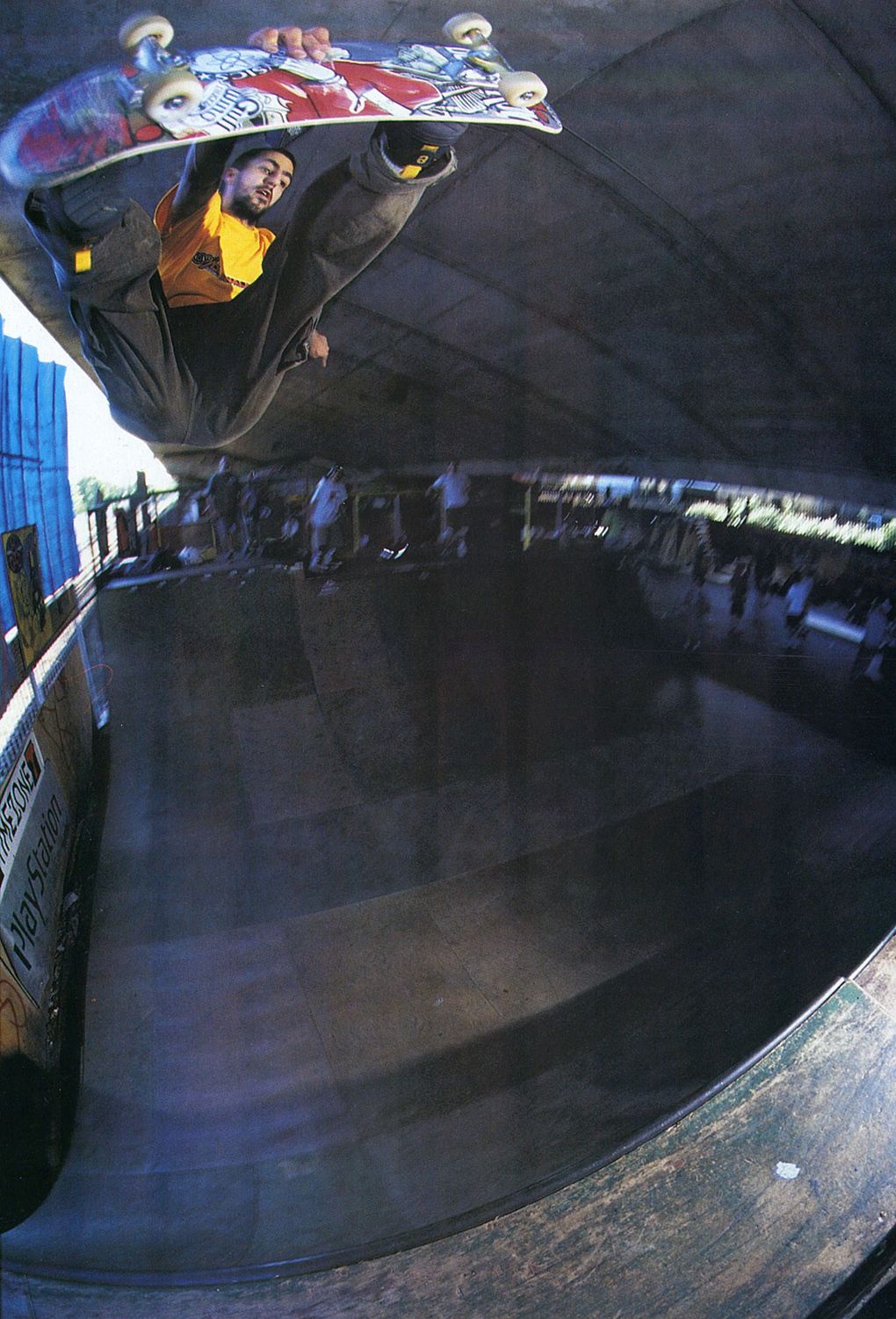
You don’t get straighter legs than this! Mike does shit properly. Photo Wig
Were you doing a much filming yourself at the time? Did you ever feel the urge to offer Neil any technical advice?
M: Yeah, I was filming at the time so I was probably annoying to film with. I probably had too many suggestions for Neil, (laughs).
N: No, he was cool! I don’t remember him asking much. It was in the Hi-8 and screw-on fisheye days, so there wasn’t much to ask about really.
It’s how he skates anyway, but were you keen to push Mike to skate regular spots in unusual ways? There was a lot of block skating, and skatepark skating, at that time, but Mike seemed really far ahead. He was hitting spots in 1999 the way people would want to now. People generally weren’t doing hippy jumps or impossibles back then.
N: Yeah, some of the guys were older and – not to sound lame – would take a long time to film a ‘street’ part! So we went to some parks. But Mike just hit the London streets full-bore. I wouldn’t say it was far ahead, it was just him, his persona and skate character doing what he did, literally just hitting anything that he came up against. I didn’t need to push him at all, I’d say it was him pushing – or more so dragging – me around London!
M: I have a very limited trick bag to pick from so I tried to make up for lack of skills with a little creativity, I suppose.
You’ve been around getting coverage since modern UK coverage began, and your first cover (Sk8 Action, February 1990) and your RAD intro (January 1990) were alternate angles of the same trick. Have you ever been conscious of how your skateboarding is perceived? Did you ever feel the need to put in ‘Mike Manzoori tricks’, or ‘Mike Manzoori spots’, or is it just natural?
M: I’ll take what I can get! For the most part you run with what works for you and what feels good. There was a weird period in the early ’90s where skateboarding was going through a lot of changes and I was pressured by team managers to skate a certain way to ‘keep with the times’, but I always enjoy skating everything so it didn’t make much difference to me. It’s funny you bring up the Sk8 Action cover and RAD mag intro being the same moment, it made me realize a lot about camera angles and how a slight adjustment goes a long way
Had the Caramac addiction subsided by 1999?
M: Yes, I was starting to grow up, (laughs).

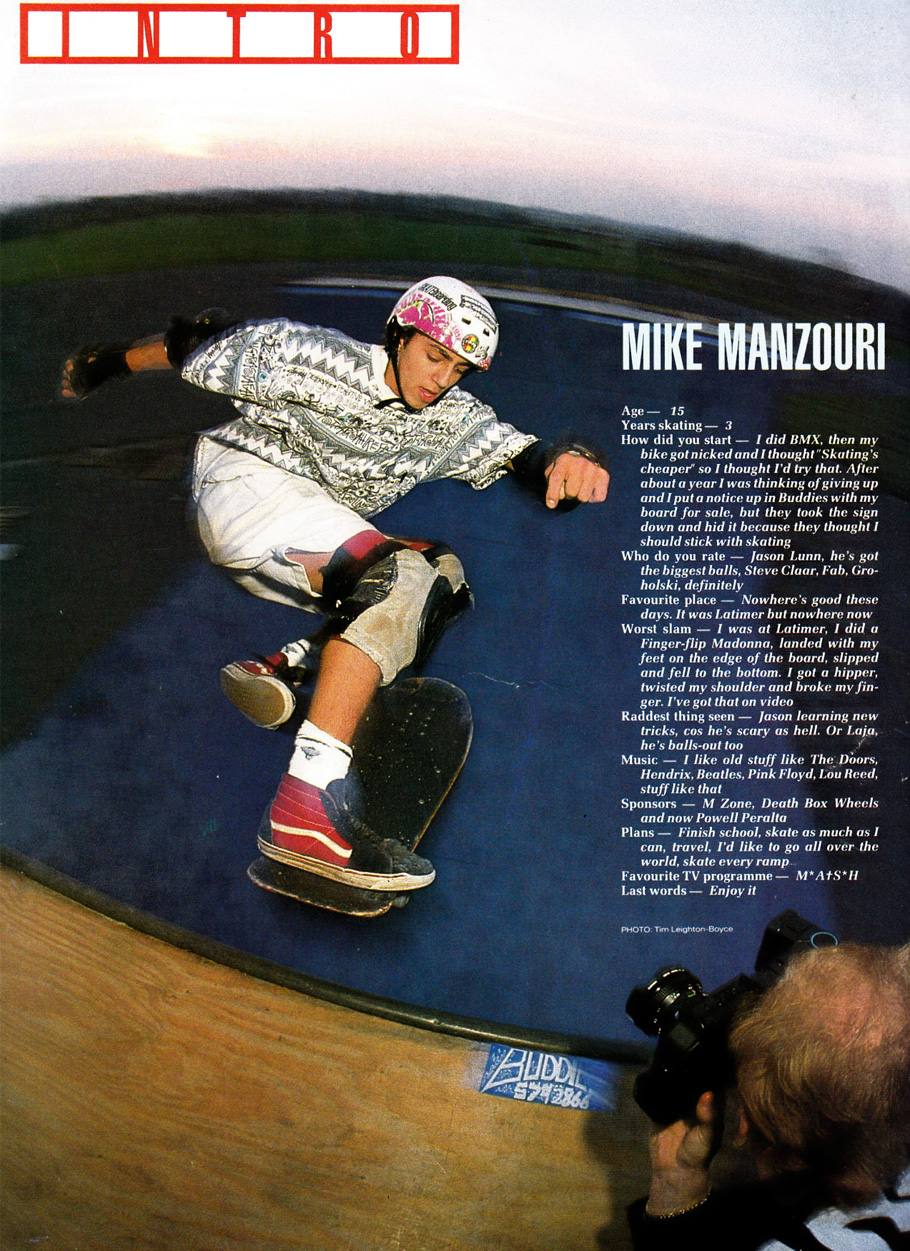
What was the scariest thing? The ender looks pretty frightening.
M: There was an ender? I thought it just fizzled out… I think Neil had become aware of my fear of rails so I think that’s why he stacked a few of them up at the end.
London architecture is in a state of permanent flux – that must have kept things interesting, not knowing what you’d find day-to-day. Thinking about the Smith on the bent railing here… Was that helpful, or a hindrance?
M: That’s the beauty of skating in cities and skating from spot to spot – cities are always evolving and some spots are only temporary like the bent guardrail. Also you just don’t see too many spots when trains are underground
N: Oh that aspect of London was definitely helpful! It was organic and spontaneous, plus we’d go out to random suburbs on the tube, not just the city. Or just push from like Baker Street to Ladbroke Grove to Camden, literally miles! Less ‘spots’ and more ‘terrain’.
What’s it like skating (or filming) in London now, compared to back then?
M: These days my visits to London are unfortunately fewer and further apart so I’m probably not too qualified to answer this accurately. If I visit Europe for work I try to make a stop in the UK but it’s more about catching up with family then skating. London seems busier them ever so I’ll try to squeeze in a solo night mission where I’ll skate from somewhere like Kings Cross back to my sister’s place in Crystal Palace. I enjoy the nostalgia of feeling the different surfaces and rhythms of UK pavement. It seems like there’s still so much waiting to be skated.
N: I haven’t done it for a few years but it was hard, one of the toughest cities I’d say, so much traffic of both cars and people and random city things, or you’d take to tube ten stops and a car would be in the way of the spot… And then there’s the rain! Also, back then spots were far less rinsed, there weren’t so many people filming, and not so many pro skaters out doing it. Plus the biggest issue is security and police; London became pretty locked down, this was before 2001!
Your boards back then looked like filmer boards nowadays Mike: what size boards and wheels were you riding?
M: Whatever size board I could get really, I think around eight-ish boards. Bigger wheels for sure, if you’re pushing around town. Some spots I might have been riding cruiser wheels to deal with the surface.
Whose skateboarding did you like at the time? I’d guess at Chris Senn or Mike Maldonado – or, obviously, Mark Gonzales.
M: I was skating with Chris a lot in SF at the time so he was very influential, as was the rest of the Adrenalin team: Jaya Bonderov, Hanzy Driscoll, Justin Strubing and Toad. Mark Gonzales is everyone’s influence whether they realize it or not.
Did you skate with him a lot when you were on the same team?
M: Nah, I’d just see him around a lot in SF when we both lived there, or sometimes I’d see him around LA, or wherever really. He just pops up randomly – often skating solo – and it’s so sick to see in passing. I was recently in traffic and got to watch Paulo Diaz shredding down the street. We were roughly parallel for almost a mile. He was completely in the zone, hitting little nibbles along the way and he looked like he was in heaven. I was reduced to my inner grom and loved it!
Gonz once said that street skating is a form of the blues. Do you see it like anything in particular? People who seem to be so natural usually have some kind of philosophy…
M: It’s a great way to forget the blues. It’s like a combination of meditation, exhilaration and a whole lot of trial and error along the way. There are not many things you can do which are so immersive and yet require such active participation and collaboration of your brain and body. It’s not just keeping the ball in play within the lines, ’cause the game is constantly changing and you choose how you interact with the lines. You are your own referee and the game is with yourself.
This video was around the time when big money was starting to come into skateboarding. You’ve always seemed to have done your own thing, your own way and on your own terms, but was it tangible that that side of things were starting to change, (for better or for worse)?
M: It was very apparent things were changing a lot. Of course some negativity creeps in but overall more of skateboarding is better. I remember being very young and being confused by older skaters clinging to the way it used to be like that was better. It’s always someone’s golden era whether you choose to be a part of it or not.
N: Not sure I’d say big money! Even now ‘big money’ is in skateboarding but there are still so many skaters not earning anything. We certainly didn’t really see that it was changing, in the UK it was very DIY, kinda still is.
Is there a golden era of skateboard videos?
M: It’s different for everyone depending on your era of discovery. I think making videos used to be more fun when no one had to clear music, but as far as creativity goes there’s a lot more room for that these days as the viewers are more open minded. Back then it was just trick, trick, trick, trick. There’s value in both approaches.
N: Maybe, it’s definitely nostalgia-based but to me, old videos like old Powell, H-Street, the first Plan B video etc are amazing. But I wouldn’t say that they’re definitively ‘golden’ because videos like Bon Appétit, Mosaic, Mindfield etc show that it’s constantly golden. How long in the future we’ll still see classics like this I’m not sure, but to counter that the new Polar video (I Like It Here Inside) is the best film for many years, and that has many nods to the ‘golden era’ throughout it so maybe that just works for me but it’s just damn sick.
What was the next thing you worked on after Hating Life Neil, and where did you go from there?
N: I filmed for Blueprint more, on ‘Waiting For The World’ then I went to the US with Manzoori and helped film over there with him for a bit at Sole Tech. Then more UK stuff back home, worked for Sidewalk for a while and made the Sidewalk video ‘In Motion’, then went full-time at Blueprint filming ‘Lost and Found’ and then ‘Make Friends with the Colour Blue’, but also working for the brand alongside Magee keeping it all rolling. It was very hard then and still is today to become a sole filmer. You need to be multi-skilled and able to do other things.
Whose filming were you into at the time? The Zoo York videos, The Storm, 5ive Flavours, Jump off a Building and Fulfil the Dream were all coming out around that time, did anything at the time blow you away?
N: Welcome to Hell was cool; I think that might have been out around then (1996)? Eastern Exposure 3 was also a huge influence. I more studied other videos for structure. I’d count tricks in parts, like you need about 30 things for a decent length part, like seven or so lines and a bunch of single tricks will put you in a good place. Depends on the guy of course, but that still holds up today. Or 20 and some slow-mo!
Mike, were you doing a lot of painting at the time of Hating Life?
M: Yeah, I had a lot more time to spare back then
When was the point where you became aware you were spending more time behind the camera Mike, rather than in front of it? Now you film in the US for the people who got Hating Life made. How did things evolve to this point?
M: Around the time Hating Life video was being made I was struggling with back problems (sciatica) and other injuries, so the transition from filming each other to being the one behind the camera more was fairly natural and almost by default.
What do you miss most between Ewer Street and the original Southbank?
M: Both those places had really unique vibe. Ewer Street had an incredible energy to the sessions. The ceiling started out square but bulged into arches as it struggled to contain our hype. We could not believe London had a legit skatepark, and no one thought it would last (which it didn’t), so that summer we milked it for all we could. Even after it was closed down we broke in and skated. Southbank, on the other hand, spanned a lot more time so the memories drift between various eras and all the legendary London rippers it attracted, like Curtis McCann, Simon Evans, Tony Luckhurst, Jason Maldini, Matt McMullen (RIP) and of course Ben Jobe. I always love pushing around the city from spot to spot. London has so much variety to skate, so I never really saw Southbank as the destination, but more as the place to start and/or end the day.
Mike Manzoori - Hating Life from Video Days on Vimeo.

